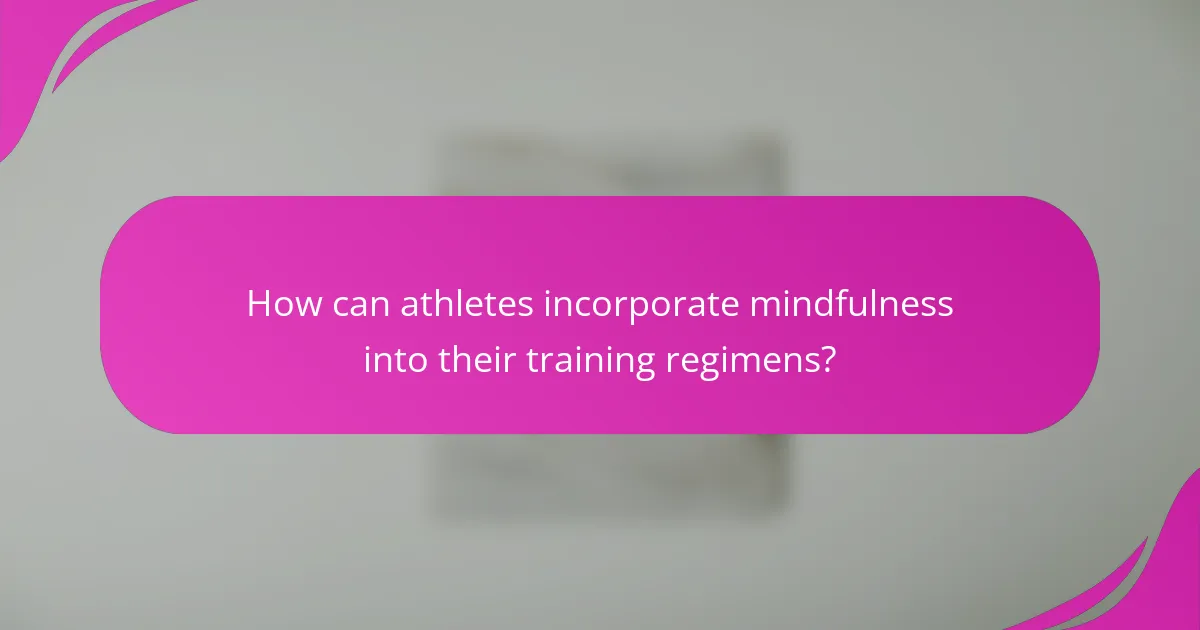Mental fatigue can hinder athletic performance and recovery. Mindfulness practices for athletes, such as meditation, breath awareness, and visualization, help manage stress and enhance focus. These techniques promote mental resilience and improve overall well-being. Incorporating personalized approaches and nature-based mindfulness can further optimize training outcomes.

What are the core mindfulness practices for athletes?
Core mindfulness practices for athletes include meditation, body scanning, breath awareness, and visualization. These techniques help athletes manage stress, enhance focus, and improve recovery. Regular meditation can significantly reduce mental fatigue, while body scanning promotes awareness of physical sensations. Breath awareness is essential for regulating emotions and maintaining composure during competition. Visualization aids in mental rehearsal, boosting confidence and performance. Integrating these practices into training routines fosters resilience and mental clarity, crucial for athletic success.
How does mindfulness help in overcoming mental fatigue?
Mindfulness significantly reduces mental fatigue by promoting relaxation and enhancing focus. Techniques like meditation and breathing exercises help athletes manage stress and improve cognitive function. Research shows that regular mindfulness practice can lead to a 30% increase in mental clarity. This improvement allows athletes to recover faster and maintain peak performance during training and competition.
What are the benefits of mindfulness for athletic recovery?
Mindfulness significantly enhances athletic recovery by reducing stress, improving focus, and promoting relaxation. Practicing mindfulness techniques such as meditation can lower cortisol levels, which aids in muscle recovery. Additionally, athletes report improved sleep quality and mental clarity, contributing to overall performance. Regular mindfulness practices can foster a positive mindset, helping athletes manage competition-related anxiety and fatigue.

What universal attributes define mindfulness practices for athletes?
Mindfulness practices for athletes share universal attributes that enhance mental clarity and focus. Key attributes include breath awareness, body scanning, and visualization techniques. These practices help reduce stress, improve concentration, and facilitate recovery. Regular engagement fosters resilience, enabling athletes to overcome mental fatigue effectively. Additionally, incorporating mindfulness into training routines can lead to improved performance and overall well-being.
How do mindfulness techniques enhance focus and concentration?
Mindfulness techniques significantly enhance focus and concentration by training the mind to remain present. These practices reduce mental fatigue, allowing athletes to recover more effectively during training and competition. Techniques such as meditation and breathing exercises improve attention span and cognitive clarity, fostering a heightened awareness of performance. As a result, athletes experience improved decision-making and execution under pressure, leading to better overall outcomes in their sport.
What role does breath control play in mindfulness?
Breath control significantly enhances mindfulness by promoting focus and reducing mental fatigue. It helps athletes center their thoughts, allowing for better concentration during recovery. Controlled breathing techniques, such as diaphragmatic breathing, can lower stress levels and increase oxygen flow, improving overall performance. This practice also fosters a unique connection between body and mind, essential for effective recovery.

What unique attributes distinguish mindfulness practices tailored for athletes?
Mindfulness practices for athletes uniquely emphasize mental resilience, focus enhancement, and stress reduction. These practices often incorporate visualization techniques tailored for performance, which are less common in general mindfulness. Additionally, the integration of breath control is specifically adapted to align with athletic training, promoting optimal physical and mental states during competition.
How can visualization techniques improve performance?
Visualization techniques can significantly enhance athletic performance by improving focus and reducing mental fatigue. These techniques help athletes mentally rehearse their actions, leading to better execution during competitions. Research indicates that athletes who engage in visualization report increased confidence and reduced anxiety, which are vital for optimal performance. Additionally, visualization aids in recovery by allowing athletes to mentally process their experiences, fostering a positive mindset.
What specific mindfulness exercises are best for recovery?
Mindfulness exercises that are best for recovery include body scans, mindful breathing, and guided visualization. These practices help athletes manage stress, enhance focus, and promote relaxation. Body scans increase body awareness, allowing athletes to identify tension and release it. Mindful breathing improves oxygen flow and reduces anxiety, while guided visualization aids in mental rehearsal and recovery imagery. Incorporating these exercises into a routine can significantly enhance mental resilience and overall recovery.

What rare attributes can enhance mindfulness practices for athletes?
Incorporating rare attributes can significantly enhance mindfulness practices for athletes. These attributes include sensory immersion, which involves deepening focus through heightened awareness of surroundings, and the use of biofeedback tools that provide real-time physiological data, allowing athletes to adjust their mindfulness techniques effectively. Another rare attribute is the integration of nature-based mindfulness, where outdoor environments are utilized to foster a sense of connection and calm. Lastly, personalized visualization techniques tailored to an athlete’s specific sport can improve mental resilience and focus during performance.
How do cultural perceptions of mindfulness influence practice?
Cultural perceptions of mindfulness shape its practice by influencing techniques and attitudes toward mental health. In cultures that prioritize collective well-being, mindfulness may emphasize community support, enhancing athletes’ recovery through shared experiences. Conversely, in individualistic cultures, mindfulness might focus on personal achievement, potentially increasing mental fatigue. These differing perspectives can affect how athletes integrate mindfulness into their training, impacting their overall performance and recovery strategies.
What innovative mindfulness approaches are emerging in sports?
Innovative mindfulness approaches in sports focus on mental resilience and recovery. Techniques like visualization, breath control, and body scanning are gaining traction. Athletes use virtual reality for immersive mindfulness experiences, enhancing focus and emotional regulation. Research shows these practices reduce anxiety and improve performance metrics. Integrating mindfulness into training routines fosters a holistic approach to athlete well-being.

How can athletes incorporate mindfulness into their training regimens?
Athletes can incorporate mindfulness into their training by practicing focused breathing, visualization techniques, and meditation. These methods help reduce mental fatigue and enhance recovery.
Focused breathing involves concentrating on breath patterns to calm the mind and improve focus. Visualization techniques allow athletes to mentally rehearse performance scenarios, reinforcing positive outcomes. Meditation fosters a state of awareness, helping athletes manage stress and maintain concentration during training and competition.
Regularly integrating these mindfulness practices can lead to improved mental resilience, better performance, and a more enjoyable training experience.
What are the best practices for daily mindfulness routines?
Daily mindfulness routines for athletes should focus on consistency and simplicity. Start with short meditation sessions, gradually increasing duration. Incorporate breath awareness to enhance focus and reduce mental fatigue. Utilize visualization techniques to improve performance and recovery. Engage in mindful movement practices, such as yoga or tai chi, to foster body awareness. Finally, maintain a gratitude journal to cultivate a positive mindset and resilience.
What common mistakes should athletes avoid in mindfulness practice?
Athletes should avoid common mistakes in mindfulness practice to enhance focus and recovery. Neglecting consistency can hinder progress; regular practice is essential. Focusing too much on results instead of the process can create unnecessary pressure. Additionally, comparing oneself to others can lead to frustration. Finally, overlooking the importance of breath awareness may limit the benefits of mindfulness.
What expert insights can enhance mindfulness effectiveness for athletes?
Incorporating expert insights can significantly enhance mindfulness effectiveness for athletes. Techniques such as visualization, breath control, and body scanning improve focus and reduce mental fatigue. Research indicates that consistent mindfulness practice can lead to a 20% increase in recovery speed. Additionally, integrating mindfulness into training routines fosters resilience and emotional regulation, essential for peak performance.